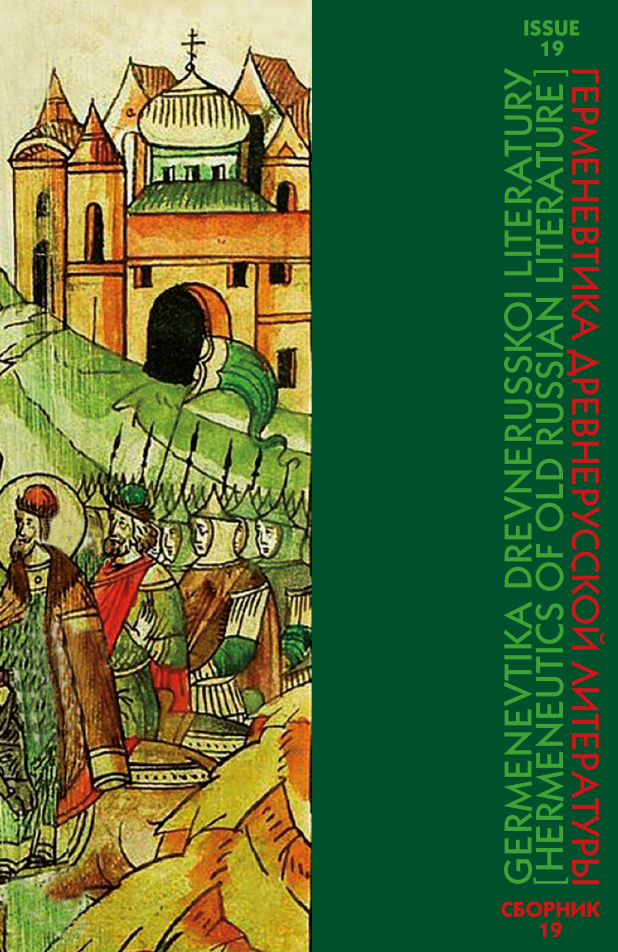Acknowledgements
The article was completed with the support of the Russian Science Foundation, project No. 22-18-00005.
Abstract
The article provides a comparative analysis of the earliest Byzantine and Old Russian images of John Climacus. The author proves that the use of psychological techniques by John Climacus in the book contributes to the activation of creative acts of self-knowledge and reflection in the reader. This influenced the fact that everywhere at an early stage, before the formation of stable iconographic types, the image of the Climacus was interpreted in different ways, as a cultural reflection to the book of the saint. In Byzantium, the first images of Climacus are illustrations for his book. The fact that the book was widely interpreted in visual images suggests that the Greeks viewed Heavenly Ladder more as a textbook on asceticism; theological work; the creation of the great teacher of the Church, which could be decorated and accompanied by visual illustrative material. When a saint was depicted outside the context of his book in monumental art, his image was placed among a host of other saints monks and was extremely typified. The icons of the saint were absent in the Byzantine tradition until the 14th century. The first images of John the Climacus in ancient Russian culture show that here the Heavenly Ladder was perceived as a practical guide to spiritual life and a patericon, and the Climacus himself was revered on a par with the stylites and great ascetics. The book Heavenly Ladder was not illustrated at all until the 14th century. At the same time, the image of the saint was immediately included in the system of monumental paintings, where it was located directly next to the altar apse, and the first worship icon of the saint was painted already in the 13th century in Veliky Novgorod.
REFERENCES
1 Gladysheva, E.V. “Ikona ‘Ioann Lestvichnik, Georgii i Vlasii’ [“The Icon of ‘John Climacus, George and Blasius’.”]. Iskusstvoznanie. Zhurnal po istorii i teorii iskusstva, no. 2, 1999, pp. 498–509. (In Russian)
2 Gubareva, O.V. “Sinaiskaia ikona ‘Videnie Lestvitsy prepodobnomu Ioannu Lestvichniku’ (XII vek) kak obraz Bozhestvennoi pedagogiki” [“The Sinai Icon ‘Vision of the Ladder to St. John the Climacus’ (12th Century) as an Image of Divine Pedagogy”]. Vremennik Zubovskogo instituta, no. 3 (42), 2023, pp. 117–124. (In Russian)
3 Daniel’, S.M. Iskusstvo videt’: o tvorcheskikh sposobnostiakh vospriiatiia, o iazyke linii i krasok i o vospitanii zritelia [Art of Seeing: on the Creative Abilities of Perception, on the Language of Lines and Colors and on the Education of the Viewer]. Leningrad, Iskusstvo Publ., 1990. 221 p. (In Russian)
4 Dorofeeva, L.G. “Topos lestvitsy v Zhitii Ioanna Sinaiskogo (na materiale Optinskogo perevoda ‘Lestvitsy’)” [“Topos of Ladder in the Life (Vita) of John the Sinai (Based on the Optina Translation of the ‘Ladder’).”]. Germenevtika drevnerusskoi literatury [Hermeneutics of Old Russian Literature]. Issue 22. Ed.‑in‑chief O.A. Tufanova. Moscow, IWL RAS Publ., 2023, pp. 312–328. https://doi.org/10.22455/HORL.1607-6192-2023-22-312-328 (In Russian)
5 Pivovarova, N.V. Freski tserkvi Spasa na Nereditse v Novgorode: ikonograficheskaia programma rospisi [Frescoes of the Church of the Savior on Nereditsa in Novgorod: Iconographic Painting Program]. St. Petersburg, ARS Dmitrii Bulanin Publ., 2002. 255 p. (In Russian)
6 Pokrovskii, A., prot. Pravoslavno-khristianskoe nravstvennoe bogoslovie. [Orthodox Christian Moral Theology]. Saratov, Tip. Gub. Zemstvo Publ., 1909. 236 p. (In Russian)
7 Popova, T.G. Lestvitsa Ioanna Sinaiskogo v slavianskoi knizhnosti [Ladder of John of Sinai in Slavic Literature]. Saarbriuken, LAP LAMBERT Publ., 2011. 457 p. (In Russian)
8 Prokhorov, G.M. Drevniaia Rus’ kak istoriko-kul’turnyi fenomen [Old Rus’ as a Historical and Cultural Phenomenon]. St. Petersburg, Oleg Abyshko Publ., 2010. 320 p. (In Russian)
9 Sarab’ianov V.D., and E.S. Smirnova. Istoriia drevnerusskoi zhivopisi [History of Old Russian Painting]. Moscow, PSTGU Publ., 2007, pp. 208–357. (In Russian)
10 Sarab’ianov, V.D., and E.S. Smirnova, and T.Iu. Tsarevskaia. “Zhivopis’” [“Painting”]. Istoriia russkogo iskusstva: v 22 t. [Painting. History of Russian Art: in 22 vols.], vol. 4: Iskusstvo serediny XIII — serediny XIV veka [Art of the mid– 13th — mid–14th Centuries]. Moscow, Gosudarstvennyi institut iskusstvoznaniia Publ., 2019, pp. 208–357. (In Russian)
11 Shibaev, M.A. Rukopisi Kirillo-Belozerskogo monastyria XV veka. [Manuscripts of Kirillo-Belozersky Monastery of the 15th Century]. Moscow, St. Petersburg, Al’ians- Arkheo Publ., 2013. 479 p. (In Russian)
12 Corrigan, Kathleen Anne. “Constantine’s Problems: the Making of the Heavenly Ladder of John Climacus, Vat. gr. 394.” Word & Image, vol. 12/1, 1996, pp. 61–93. (In English)
13 Martin, John Rupert. The Illustration of the Heavenly Ladder of John Climacus (= Studies in Manuscript Illumination, Nr. 5). Princeton, Princeton University Press, 1954. 198 p. (In English)
14 Sevcenko, Nancy P. “Monastic Challenges: Some Manuscripts of the Heavenly Ladder.” Byzantine Art: Recent Studies. Index of Christian Art, ACMRS, and Brepols, 2009, pp. 39–62. (In English)






